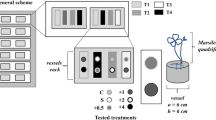Abstract
Field experiments were conducted to study the short-time response in growth and sediment properties of Zizania latifolia to four levels of water depth: 10, 50, 90, and 130 cm. The results showed that Z. latifolia was sensitive to high water depth stress in terms of the significantly decreased basal stem diameter, leaf width, root length, total biomass, and root to shoot ratio with increasing water depth. It was found suitable to grow in shallow water less than 50 cm in depth. The growth of Z. latifolia significantly increased sediment moisture content and porosity, while reduced wet bulk density in sediment and NH4–N concentration in interstitial water. Along the water depth gradient, the growth of Z. latifolia significantly impacted sediment wet bulk weight and loss on ignition, both NH4–N and PO4–P concentrations in interstitial water. However, no obvious regularities were observed in the sediment vertical profiles. NH4–N and PO4–P concentrations in interstitial water were much higher than in overlying water, indicating that they could diffuse from sediment to overlying water. NH4–N concentration was also higher in deep sediment. Growth properties of Z. latifolia (except for leaf length) are significantly correlated to wet bulk density, loss on ignition, NH4–N concentration in sediment and NH4–N, PO4–P concentrations in interstitial water. The results indicate that water depth less than 50 cm is favorable for the growth of Z. latifolia, where it can exert its ecological function effectively. This research suggests a possibility to promote the growth of Z. latifolia and exert its ecological function by rational water depth management.

Similar content being viewed by others
References
Brink FWBvd, Velde Gvd, Bosman WW, Coops H (1995) Effects of substrate parameters on growth responses of eight helophyte species in relation to flooding. Aquat Bot 50:79–97
Carber KJ, Hartman RT (1985) Internal phosphorus loading to shallow Edinboro Lake in northwestern Pennsylvania. Hydrobiologia 122(1):42–45
Crawford RMM (1996) Whole plant adaptations to fluctuating water tables. Folia Geobot Phytotax 31:7–24
Deegan BM, White SD, Ganf GG (2007) The influence of water level fluctuations on the growth of four emergent macrophyte species. Aquat Bot 86:309–315
Deegan BM, White SD, Ganf GG (2010) Nutrients and water level fluctuations: A study of three aquatic plants. River Res Appl. doi:10.1002/rra.1461
Dinakaran J, Krishnayya NSR (2010) Variations in soil organic carbon and litter decomposition across different tropical vegetal covers. Curr Sci 99(8):1051–1060
Grace JB (1989) Effects of water depth on Typha latifolia and Typha Domingensis. Am J Bot 76(5):762–768
Gribsholt B, Kostka JE, Kristensen E (2003) Impact of fiddler crabs and plant roots on sediment biogeochemistry in a Georgia saltmarsh. Mar Ecol Prog Ser 259:237–251
Jin X, Tu Q (1990) Lake eutrophicaiton investigation standard, 2nd edn. China Environmental Science Press, Beijing
Lange GJd (1992) Distribution of exchangeable, fixed, organic and total nitrogen in interbedded turbiditic/pelagic sediments of the Madeira Abyssal Plain, eastern North Atlantic. Mar Geol 109(1–2):95–114
Lentz KA, Dunson WA (1998) Water level affects growth of endangered northeastern bulrush, Scirpus ancistrochaetus Schuyler. Aquat Bot 60:213–219
Li E, Li W, Wang X, Xue H, Xiao F (2010) Experiment of emergent macrophytes growing in contaminated sludge: implication for sediment purification and lake restoration. Ecol Eng 36:427–434
Madsen JD, Chambers PA, James WF, Koch EW, Westlake DF (2001) The interaction between water movement, sediment dynamics and submerged macrophytes. Hydrobiologia 444:71–84
Moore BC, Lafer JE, Funk WH (1994) Influence of aquatic macrophytes on phosphorus and sediment porewater chemistry in a freshwater wetland. Aquat Bot 49(2–3):137–148
Paillisson Jm, Marion L (2006) Can small water level fluctuations affect the biomass of Nymphaea alba in large lakes? Aquat Bot 84:259–266
Rattray MR, Howad WC, Brown JMA (1991) Sediment and water as sources of nitrogen and phosphorus for submerged rooted aquatic macrophytes. Aquat Bot 40:225–237
Sand-Jensen K (1998) Influence of submerged macrophytes on sediment composition and near-bed flow in lowland streams. Freshw Biol 39(4):663–679
Sand-Jensen K, Prahl C (1982) Oxygen exchange with the Lacunae and across leaves and roots of the submerged vascular macrophyte, Lobelia dortmanna L. New Phytol 91:103–120
Smith RD, Dennison WC, Alberte RS (1984) Role of seagrass photosynthesis in root aerobic processes. Plant Physiol 74:1055–1058
Song J (1992) Transfer mode of phosphate in sediment interstitial waters of the East China sea. Mar Environ Sci 11(3):45–51
Templer P, Findlay S, Wigand C (1998) Sediment chemistry associated with native and non-native emergent macrophytes of a Hudson River marsh ecosystem. Wetlands 18:70–78
Visser EJW, Voesenek LACJ (2004) Acclimation to soil flooding–sensing and signal-transduction. Plant Soil 254:197–214
Visser EJW, Bögemann GM, Desteeg HMv, Pierik R, Blom CWPM (2000) Flooding tolerance of Carex species in relation to field distribution and aerenchyma formation. New Phytol 148:93–103
Waters I, Shay JM (1992) Effect of water depth on population parameters of a Typha glauca stand. Can J Bot 70:349–351
Weisner SEB, Strand JA (1996) Rhizome architecture in Phragmites australis in relation to water depth: implications for within-plant oxygen transport distances. Folia Geobot 31(1):91–97
White SD, Ganf GG (1998) The influence of convective flow on rhizome length in Typha domingensis over a water depth gradient. Aquat Bot 62:57–70
Wigand C, Stevenson JC, Cornwell JC (1997) Effects of different submerged macrophytes on sediment biogeochemistry. Aquat Bot 56:233–244
Acknowledgments
This research was supported by the National Natural Science Foundation of China, No. NFSC41230853 and No. 41171413.
Author information
Authors and Affiliations
Corresponding authors
Rights and permissions
About this article
Cite this article
Bai, X., Chen, K. & Chen, X. Short-time response in growth and sediment properties of Zizania latifolia to water depth. Environ Earth Sci 70, 2847–2854 (2013). https://doi.org/10.1007/s12665-013-2345-8
Received:
Accepted:
Published:
Issue Date:
DOI: https://doi.org/10.1007/s12665-013-2345-8




